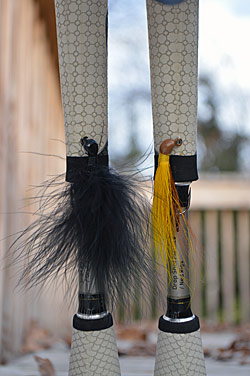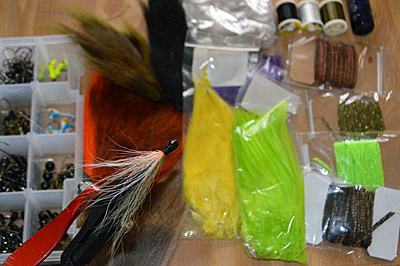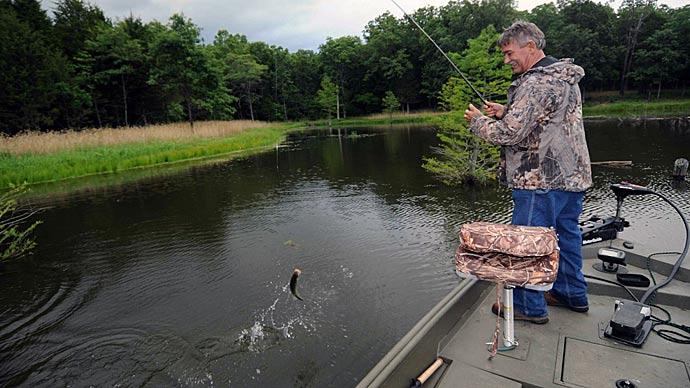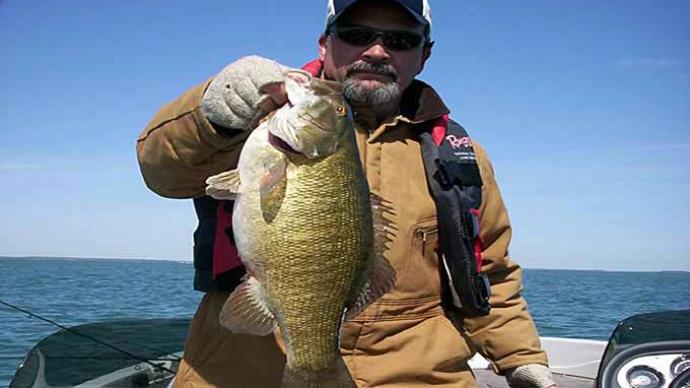
Seth Feider knows a lot about catching smallmouth bass. The lifelong angler and Bloomington, MN, resident has showcased that knowledge over the past three Bassmaster Elite Series seasons. He caught enough of them to win the 2016 Toyota Bassmaster Angler of the Year Championship at his home state’s Mille Lacs Lake and post other top finishes during stops at smallmouth fisheries. But a fellow pro angler introduced him to a particular technique about a decade ago.
Feider and FLW Tour angler Jeff Gustafson partnered for the Sturgeon Bay Open on Lake Michigan. It takes giant bags of smallmouth to win the twice-a-year tournament, where a nearly 8 ½-pounder was weighed in 2013. While the duo didn’t land any smallmouth that big, Gustafson did open Feider’s eyes to the power of a small hair jig. It has become essential to Feider’s spring and early summer smallmouth fishing.
Hair jigs are as simple a lure as you’ll find. They are assembled from three pieces: hook, weight, and body material. But within that simplicity lies plenty of versatility. They offer a natural look and action, regardless of where they are fished, that smallmouth find irresistible.
The most popular hair jigs are tied with time-tested marabou feathers or bucktail hair. Each brings unique attributes to your presentation. Here’s how to take advantage of them and tie your own.
Marabou Jigs
Feider packs hair jigs when he hits the road with the Elite Series. While he’s caught some spotted bass at Southern stops and largemouth all over with them, he said they work best for shallow smallmouth in spring and early summer. “In clear water, especially when it’s not super windy,” he said.
It’s not only time of year and conditions that Feider is particular about when fishing a hair jig. He only fishes with ones tied with marabou, feathers most often taken from chickens and turkeys. With a sturdy quill that easily ties into a jig, their fluffy plume ripples with the slightest motion, making the jig look alive underwater. “It’s the most subtle thing,” he said.

That action makes marabou jigs a good imitator of baitfish and insects such as mayflies. “It will catch big ones, but it is more of a numbers bait,” Feider said. He has caught smallmouth up to 6 pounds on one. “You’re going to catch all of them,” he said. He likened it to fishing a stick worm such as a Yamamoto Senko. As you fish along, every bass that sees it will bite it. “You just have to keep catching them, and eventually, you will catch a big one,” he said.
Feider designed a marabou jig — Feider Fly — for Outkast Tackle when he couldn’t find a production model that he liked. “The hook is crucial,” he said. It must be super sharp to penetrate with minimal effort and large enough to hold a powerful smallmouth. His go-to weight is 3/32 ounce, and he never fishes one heavier than 1/8 ounce. In extremely shallow water, he’ll drop down to a 1/16-ounce model. The light weight makes it easier for him to fish, which isn’t on the bottom in this case.
Feider swims his marabou jig slow and steady like a small swimbait, leaving out the hops and twitches that are the mainstays of fishing most hair jigs. He aims his casts, so his retrieves track across rock-sand transitions. He only alters his retrieve when it crosses an essential piece of cover such as a boulder or log. Then he’ll let his jig pendulum down, hoping to entice any smallmouth hiding there.
While the retrieve is subtle, Feider said some strikes could be aggressive, producing a telltale sharp tap. Most others involve a smallmouth inhaling the jig and swimming along with it. He describes their feel as his jig becoming heavier or reel binding. That’s why a premium spinning reel is vital for this technique. He said its smoothness makes strikes more distinguishable.
The correct line and rod help generate strikes. Feider fills his spinning reel with 6-pound test braided line, which has a diameter equivalent to 1- or 2-pound test monofilament. It’s less visible in clear water and easy to cast. He adds a 6- to 7-foot leader of fluorocarbon line to its end using an FG knot, which weaves the main line around the larger diameter leader. He said it’s extremely strong, and it needs to be. To generate casting distance with the light-weight jig, he deeply loads his rod — a medium light, fast action 7 ½-footer designed for Daiwa’s Tatula Elite line — before whipping it forward.
Rod speed is one factor in a long cast. “You have to get the jig wet before you can cast it,” Feider said. Marabou holds water like a sponge, and every drop adds weight. He adds more by slipping a half-inch piece of Senko onto the hook, locking it with the keeper he incorporated into the Feider Fly’s design. While it can be a piece of any soft-plastic lure, his choice comes down to salt content. Senkos have a lot, which makes them heavier than the same-sized piece of salt-free plastic.
Feider matches the color of his Senko piece to his jig, which is almost always black. That way, it blends in after you’ve caught a bunch and the marabou feathers get a little beat up.
Bucktail
Feider has proven the productivity of marabou jigs. But they aren’t the only ones that catch smallmouth. Bucktail, which most bass anglers associate with hair jigs, will produce under the right conditions.
Bucktail doesn’t pulsate like marabou. Its hollow fibers create more of a quiver at rest. The slick back when moved through the water, giving the jig a gliding fall. It holds its shape when tied, so thin and wispy or big and bulky jigs are possible. Where a particular jig falls on that spectrum determines the amount of flair at rest, how fast it sinks, and how it darts with each hop.
Bucktails are an excellent choice when smallmouth are holding in deep water — 10 or more feet — or swimming in cold water. Their lack of resistance means they sink fast and stay where you cast them, regardless of the current. And their subtle action won’t turn off timid bass.
Most bucktails weigh 1/2 ounce or less. Heavier ones are available, but those are mainly used for stripers or in saltwater. Ones weighing 1/8 to 1/4 ounce will cover most smallmouth fishing conditions. You’ll be best served by throwing them on a 7-foot medium spinning rod. Fast action rods are crisp enough to launch these jigs and set the hook at the end of a long cast or deep water.
Like Feider’s marabou jig, you’ll want to use braid and a fluorocarbon leader. The zero-stretch and small diameter braid will help you feel light bites and isn’t affected by current as much as a full length of fluorocarbon or monofilament line.
The amount of action you add to a bucktail depends on the situation. When smallmouth are active, you can add plenty of big hops. It might take small twitches or slides across the bottom in cold water to generate strikes. You’ll have to experiment to uncover which one works best. Don’t forget to try different lengths of pauses. Sometimes letting it sit motionlessly will make them bite, too.
When it comes to color, stick to natural hues — those that contain brown, black or white — and match the hatch. They also complement the natural action of a bucktail jig. If you’re on a Northern fishery, try brown to match crawfish, small chubs, or suckers. Use a white jig to imitate the shad that smallmouth eat in Southern reservoirs. And don’t worry if you can’t find the exact color you need. Tying your own is a simple process. A surprisingly small selection of materials and tools can lead to an infinite number of variations.
Tie Your Own
The first thing you’ll need is a tying vice. It doesn’t need to rotate or any of the other fancy functions offered on top-of-the-line fly vices. It only needs to hold the jig head securely. You can find reasonably priced used ones online or at flea markets. Ensure the vise opens wide enough to hold the size hooks you’ll be tying. A pair of small scissors, a bobbin to hold thread, and a jar of head cement will complete your starter toolbox.

Next, you’ll need some jig heads. They can be purchased, or you can pour your own. There are many different styles of jig heads. Each one acts differently in the water and can affect the finished look of your hair jig. The ball head, for example, is the most popular. It performs well at most depths and in current. There also are flat-sided heads, which handle heavy current, and teardrops, which sink straight. It pays to tie some of each, so you are prepared for any condition.
Many jig heads are designed to accept a soft-plastic lure, such as a swimbait or grub, so they have a collar molded behind the head. Tying to the collar will cause your material, especially bucktail, to flair, making for a jig with a bigger profile. If you’re interested in creating a smaller profile, select a jig head without a collar. That will allow you to tie it directly to the hook shank. The latter also are a good choice if you want to tie other materials, such as chenille or hackle, inside the bucktail.
Once you’ve chosen a jig head, it’s time to tie. Clamp it in your vice, so the hook’s shank is on top. Lay your thread — sized 140 or 210 denier — along the shank and begin wrapping away from you. Cover about 3/16 inches of the shaft directly behind the head. This will lock the thread and give the materials something to grip.
Add small amounts of material at a time. Take one marabou feather or a small collection of bucktails and hold it against the hook shank, adding ten or so wraps to hold it in place. Repeat the process around the shank until you’ve built up the size body you want. Keep the wraps in a narrow band directly behind the head. That will give your material maximum freedom for movement.
If you need to shorten a feather or bucktail, always cut from the thicker end before tying it onto the jig. Hold it alongside the jig to determine where you need to cut. You want to preserve the tips, where fine fibers create the most action.
Finish the tie with a couple of overhand knots or a whip finish, which can be done by hand or with a unique tool. Once you’ve cut the thread, add several thin coats of head cement to lock everything in place.




